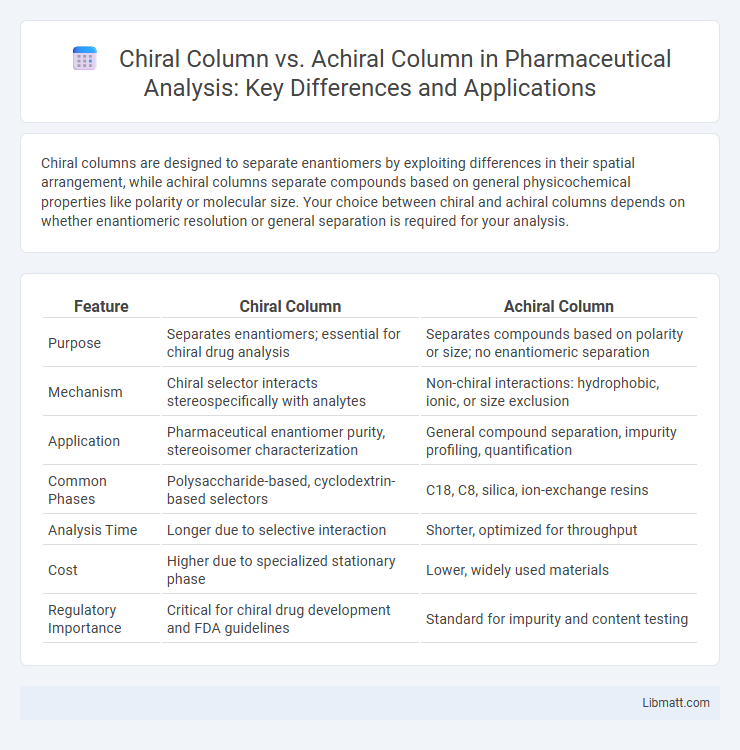Chiral columns are designed to separate enantiomers by exploiting differences in their spatial arrangement, while achiral columns separate compounds based on general physicochemical properties like polarity or molecular size. Your choice between chiral and achiral columns depends on whether enantiomeric resolution or general separation is required for your analysis.
Table of Comparison
| Feature | Chiral Column | Achiral Column |
|---|---|---|
| Purpose | Separates enantiomers; essential for chiral drug analysis | Separates compounds based on polarity or size; no enantiomeric separation |
| Mechanism | Chiral selector interacts stereospecifically with analytes | Non-chiral interactions: hydrophobic, ionic, or size exclusion |
| Application | Pharmaceutical enantiomer purity, stereoisomer characterization | General compound separation, impurity profiling, quantification |
| Common Phases | Polysaccharide-based, cyclodextrin-based selectors | C18, C8, silica, ion-exchange resins |
| Analysis Time | Longer due to selective interaction | Shorter, optimized for throughput |
| Cost | Higher due to specialized stationary phase | Lower, widely used materials |
| Regulatory Importance | Critical for chiral drug development and FDA guidelines | Standard for impurity and content testing |
Introduction to Chiral and Achiral Columns
Chiral columns are specialized chromatography columns designed to separate enantiomers based on their interaction with a chiral stationary phase, making them essential for analyzing optically active compounds in pharmaceuticals and chemicals. Achiral columns, by contrast, use achiral stationary phases and primarily separate compounds based on differences in polarity, size, or other physicochemical properties without distinguishing stereochemistry. Understanding the distinction between chiral and achiral columns helps you select the appropriate method for separating complex mixtures in analytical and preparative chromatography.
Understanding Chirality in Chromatography
Chiral columns in chromatography specifically separate enantiomers based on their interaction with a chiral stationary phase, enabling precise analysis of stereoisomers critical in pharmaceuticals and biochemistry. Achiral columns, conversely, separate compounds based on general physicochemical properties like polarity or size without distinguishing stereochemistry. Your choice between chiral and achiral columns depends on whether resolving enantiomers or general compound mixtures is required, impacting the accuracy and relevance of chromatographic results.
Structural Differences: Chiral vs Achiral Columns
Chiral columns contain specialized stationary phases with chiral selectors that differentiate enantiomers based on their stereochemistry, enabling the separation of optical isomers. Achiral columns have stationary phases lacking chiral centers, relying on differences in physical or chemical properties unrelated to chirality for separation. Your choice between chiral and achiral columns depends on whether enantiomeric resolution or general compound separation is required.
Mechanisms of Separation
Chiral columns separate enantiomers based on stereoselective interactions between the chiral stationary phase and the analytes, utilizing mechanisms such as hydrogen bonding, dipole-dipole interactions, and steric hindrance to differentiate molecules with identical physical properties. Achiral columns rely primarily on differences in polarity, molecular size, and affinity to the stationary phase, enabling separation through partitioning or adsorption without enantioselectivity. Understanding these mechanisms helps optimize your chromatographic method for resolving complex mixtures or chiral compounds efficiently.
Applications of Chiral Columns
Chiral columns are essential for separating enantiomers in pharmaceuticals, agrochemicals, and food industry applications where the distinction between stereoisomers impacts efficacy and safety. These columns utilize chiral selectors that interact differently with each enantiomer, enabling high-resolution separation critical for quality control and regulatory compliance. Your analytical workflow benefits from chiral columns when precise stereochemical analysis is required for drug development and enantiomeric purity assessment.
Common Uses of Achiral Columns
Achiral columns are primarily used in the separation and analysis of racemic mixtures, non-chiral compounds, and in routine quality control for pharmaceuticals, chemicals, and food products. They are favored for their efficiency in separating compounds based on differences in polarity, size, and charge without interaction with chiral centers. Achiral columns, such as C18, silica, and amino phases, are essential in high-performance liquid chromatography (HPLC) for general-purpose applications including impurity profiling and isomer separation.
Advantages of Chiral Columns
Chiral columns offer superior enantioselectivity by efficiently separating enantiomers, which is crucial in pharmaceutical and agrochemical industries for analyzing chiral compounds. They enhance method sensitivity and accuracy due to their ability to selectively interact with stereoisomers, reducing analytical interference. Compared to achiral columns, chiral columns provide more precise resolution of optical isomers, supporting regulatory compliance with stringent chiral drug purity standards.
Limitations of Chiral Columns
Chiral columns often face limitations such as lower loading capacity and longer analysis times compared to achiral columns, restricting their use in large-scale separations. The selectivity of chiral stationary phases can be highly specific, making method development more complex and less robust. Additionally, chiral columns generally have higher costs and may exhibit reduced stability under certain solvent conditions.
Criteria for Choosing Between Chiral and Achiral Columns
The choice between chiral and achiral columns depends primarily on the nature of the analytes and the separation goals, with chiral columns being essential for enantiomeric resolution in stereoisomeric mixtures. Achiral columns are preferred for general separation of non-chiral compounds due to their broader applicability and cost-effectiveness. Key criteria include the presence of chiral centers in the analytes, required selectivity, resolution efficiency, and the target analytical or preparative application.
Future Trends in Chromatographic Column Technology
Future trends in chromatographic column technology emphasize the integration of advanced chiral stationary phases to enhance enantiomeric separation accuracy and speed. Innovations in achiral columns focus on developing hybrid materials that improve selectivity and durability under extreme conditions. Emerging applications in pharmaceuticals and environmental analysis drive the demand for versatile columns combining chiral and achiral properties to enable comprehensive compound profiling.
Chiral column vs achiral column Infographic

 libmatt.com
libmatt.com